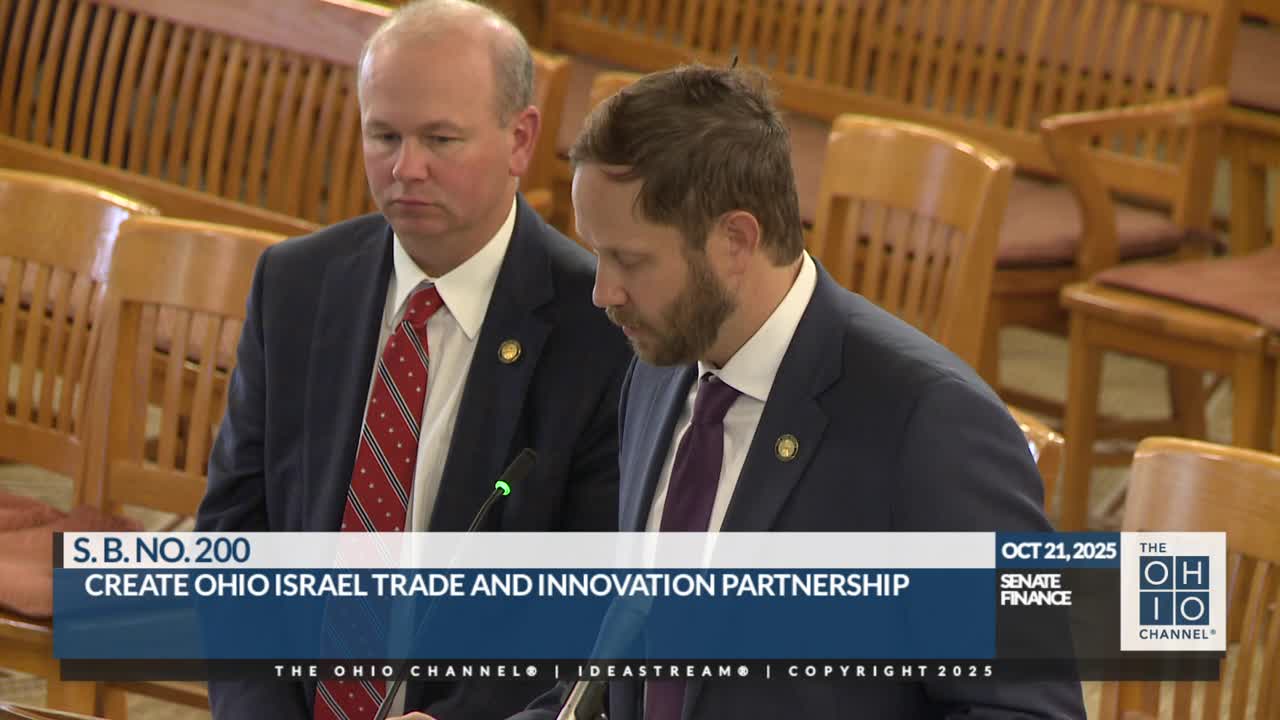Senate substitute for Bill 93 proposes statewide 20-mil property tax, 1.75% sales tax increase and statewide per-pupil funding
October 21, 2025 | Finance, Senate, Committees, Legislative, Ohio
This article was created by AI summarizing key points discussed. AI makes mistakes, so for full details and context, please refer to the video of the full meeting. Please report any errors so we can fix them. Report an error »

Senator Brenner presented sponsor testimony on Oct. 29 for a substitute version of Senate Bill 93 that would overhaul how Ohio funds its public schools by shifting revenue collection from local levies to statewide mechanisms and establishing a single statewide per-pupil amount.
"Since the pandemic, property taxes have increased sharply...This has caused a substantial increase of property taxes on millions of homeowners," Brenner said, explaining the proposal would reduce reliance on local property taxes and move toward a uniform funding approach. Under the substitute, the state would collect a 20-mill property tax dedicated to schools, increase the state sales tax by 1.75 percentage points (bringing the total to 7.5%), and continue lottery and sports-gaming revenues as supplemental school funding.
The substitute would repeal local school levies for school funding and prohibit local governments from using certain inside mills for school support. Brenner said the plan would replace district-specific per-pupil calculations with a single statewide average set at $11,535 per student and would have that funding "follow the student" to the school of their choice, including public and chartered nonpublic schools (excluding non-chartered nonpublic schools). He said categorical adjustments (special education, English learners, career technical students, gifted, transportation) would remain and be used to modify base funding.
Brenner described a companion proposal, Senate Joint Resolution 4, to amend the Ohio Constitution to allow the state to assume outstanding local school debt so districts would not be left unable to pay existing obligations if they lose levy authority. The substitute also shifts transportation responsibilities to regional education service centers (ESCs), encourages voluntary consolidation via memoranda of understanding, and contemplates synchronized bell schedules for efficiency.
Committee members offered a mix of praise and questions. Senator Blessing called the plan "very thoughtful" and noted it addresses numerous levies and transportation economies. Senator O'Brien asked about local control, the constitutionality and mechanics of state assumption of debt, and whether the joint resolution might render the bill moot if a different property-tax repeal amendment passed; Brenner responded that local boards would continue to operate schools and that the companion constitutional amendment would be necessary to address outstanding debt and the bill's implementation.
Senator Ingram and others asked technical questions about categorical funding, transportation coordination, funding flows when students attend charter or e-schools, and the fiscal implications of shifting revenue sources. Brenner said the proposal was designed to preserve categorical adjustments, follow ADM counts, and potentially provide greater funding predictability while encouraging local innovation and consolidation. The committee did not vote on the substitute; the hearing generated extensive policy questions that sponsors said would require follow-up.
"Since the pandemic, property taxes have increased sharply...This has caused a substantial increase of property taxes on millions of homeowners," Brenner said, explaining the proposal would reduce reliance on local property taxes and move toward a uniform funding approach. Under the substitute, the state would collect a 20-mill property tax dedicated to schools, increase the state sales tax by 1.75 percentage points (bringing the total to 7.5%), and continue lottery and sports-gaming revenues as supplemental school funding.
The substitute would repeal local school levies for school funding and prohibit local governments from using certain inside mills for school support. Brenner said the plan would replace district-specific per-pupil calculations with a single statewide average set at $11,535 per student and would have that funding "follow the student" to the school of their choice, including public and chartered nonpublic schools (excluding non-chartered nonpublic schools). He said categorical adjustments (special education, English learners, career technical students, gifted, transportation) would remain and be used to modify base funding.
Brenner described a companion proposal, Senate Joint Resolution 4, to amend the Ohio Constitution to allow the state to assume outstanding local school debt so districts would not be left unable to pay existing obligations if they lose levy authority. The substitute also shifts transportation responsibilities to regional education service centers (ESCs), encourages voluntary consolidation via memoranda of understanding, and contemplates synchronized bell schedules for efficiency.
Committee members offered a mix of praise and questions. Senator Blessing called the plan "very thoughtful" and noted it addresses numerous levies and transportation economies. Senator O'Brien asked about local control, the constitutionality and mechanics of state assumption of debt, and whether the joint resolution might render the bill moot if a different property-tax repeal amendment passed; Brenner responded that local boards would continue to operate schools and that the companion constitutional amendment would be necessary to address outstanding debt and the bill's implementation.
Senator Ingram and others asked technical questions about categorical funding, transportation coordination, funding flows when students attend charter or e-schools, and the fiscal implications of shifting revenue sources. Brenner said the proposal was designed to preserve categorical adjustments, follow ADM counts, and potentially provide greater funding predictability while encouraging local innovation and consolidation. The committee did not vote on the substitute; the hearing generated extensive policy questions that sponsors said would require follow-up.
View full meeting
This article is based on a recent meeting—watch the full video and explore the complete transcript for deeper insights into the discussion.
View full meeting
